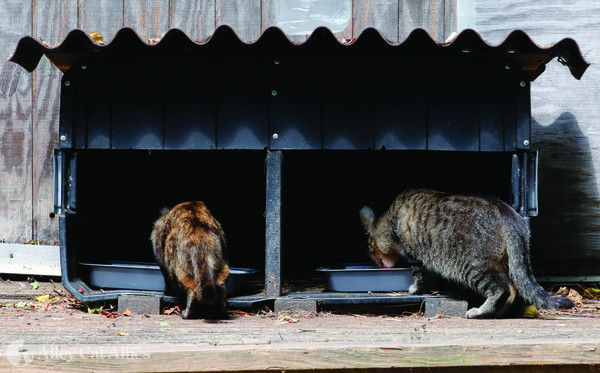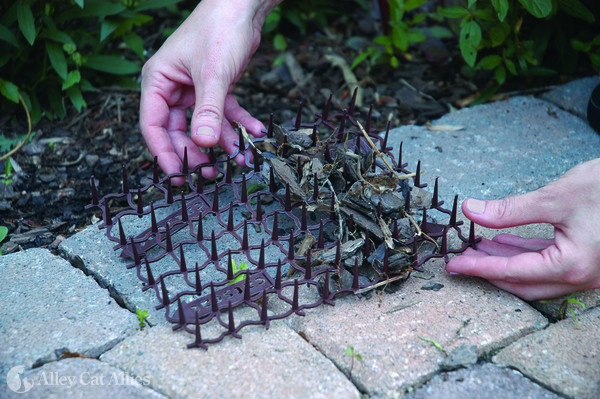Now available in both Spanish and French!
What is a community cat?
Community cats, also called feral cats, are unowned cats who live outdoors. Like indoor cats, they belong to the domestic cat species (felis catus). However, community cats are generally not socialized, or friendly, to people, and are therefore unadoptable. They live full, healthy lives with their feline families, called colonies, in their outdoor homes.
Learn more with our Cat Socialization Continuum Guide!
Cats living outdoors is nothing new. It wasn’t until kitty litter was invented in the late 1940s that some cats began living strictly indoors. But community cats truly thrive in their outdoor homes. The tips in this brochure will help you coexist with community cats.
Why do I see community cats in my neighborhood?
Community cats live outdoors. Like all animals, community cats settle where food and shelter are available, and they are naturally skilled at finding these on their own.
Because they are unsocialized, community cats can’t live indoors with people, and are therefore unadoptable. Community cats should not be taken to animal shelters–nationwide, too many shelters still kill most cats who enter their doors. Trap-Neuter-Return (TNR) is the humane, effective, and mainstream approach to addressing community cat populations.
What is Trap-Neuter-Return?
In a TNR program, community cats are humanely trapped, brought to a veterinarian to be spayed or neutered, vaccinated, eartipped (the universal sign that a cat is part of a TNR program), and then returned to their outdoor homes. Kittens less than 8 weeks old can be socialized and then adopted. Adult cats who are socialized can be adopted, but they can also be returned outdoors, where they will continue to thrive.
TNR improves cats’ lives and provides an effective, humane, and collaborative way for communities to coexist with cats. To learn more, including how to conduct TNR, visit alleycat.org/TNR.
What does the Vacuum Effect have to do with TNR?
The Vacuum Effect has been documented worldwide in many species, including community cats. Animal control’s typical approach has been to catch and kill community cats. While this may temporarily reduce the number of community cats in a given area, it is ultimately counterproductive, as the population of cats rebounds. Other cats move into the newly available territory and continue to breedthis phenomenon is called the Vacuum Effect. It’s why catch and kill doesn’t work. TNR is the only effective and humane approach to address community cat populations.
Learn more at alleycat.org/VacuumEffect.
What You Should Do If…
Cats get in your trash.
Reason: Cats are looking for food.
Feeding stations provide cats with a designated area to eat.
3 Quick Tips to Keep Cats Out of Your Garbage:
1. Secure your trash can with a tight lid or bungee cords. This will protect your trash from wildlife as well.
2. Find out if neighbors are feeding the cats. If they are, make sure they are following best practices. Learn more at alleycat.org/BestPractices.
3. Consider feeding the cats yourself if you find no regular caregiver. Feeding cats using best practices will help ensure they don’t get hungry enough to get into trash.
Cats dig in your garden.
Reason: It is a cat’s natural instinct to dig in soft or loose soil, moss, mulch, or sand.
6 Quick Tips to Help Keep Cats From Digging
1. Put out fragrances that keep cats away. Scatter fresh orange or lemon peels. Metal pans filled with vinegar also deter cats.
2. Make an outdoor litter box away from your garden by tilling the soil or placing sand in an out-of-the-way spot in your yard. Clean the area frequently.
3. Use plastic carpet runners, spike-side up, covered lightly in soil. They can be found at hardware or office supply stores. You can also set chicken wire firmly into the dirt (roll sharp edges under), arrange branches or sticks in a lattice pattern, or put wooden or plastic fencing over soil.
4. Get the Cat Scat Mat, a non-chemical cat deterrent consisting of plastic mats that are cut into smaller pieces and pressed into the soil (pictured). Each mat has flexible plastic spikes that are harmless to cats and other animals but discourage digging.
5. Get motion-activated sprinklers.
6. Cover exposed ground in flower beds with large river rocks to prevent cats from digging. Rocks have the added benefit of deterring weeds.
Cats lounge in your yard or porch, or on your car.
Reason: Cats tend to remain close to their food source.
4 Quick Tips:
1. Shift the cats’ food source to a less central location, where you won’t mind if they hang out.
2. Apply fragrances that deter cats around the edges of your yard, the tops of fences, and on any favorite digging areas or plants. See “Cats are digging in your garden” for a list of cat-deterring fragrances.
3. Install an ultrasonic deterrent or a motion-activated sprinkler. You can find humane deterrent products at garden supply stores.
4. Use a car cover or place carpet runners on top of your car to avoid paw prints.
Cats sleep under your porch or in your shed.
Reason: The cats are looking for a dry, warm shelter away from the elements.
2 Quick Tips:
1. Provide covered shelter. Or, if the cats have a caregiver, ask the caregiver to provide covered shelter. Shelters should be placed in quiet areas away from traffic.
2. Block or seal the area where the cats enter with chicken wire or lattice, but only once you are absolutely certain no cats or kittens are inside.
Feeding cats attracts insects and wildlife.
Reason: Leaving food out for too long can attract other animals.
2 Quick Tips:
1. Feed the cats at the same time and location each day. They should be given only enough food to finish in one sitting. If another person is caring for the cats, ask them to follow these guidelines. For more colony care guidelines, visit alleycat.org/ColonyCare.
2. Keep the feeding area neat and free of leftover food and trash.
Cats are yowling, fighting, spraying, roaming, and having kittens.
Reason: These are mating behaviors. Once the cats are spayed or neutered, these behaviors will stop.
2 Quick Tips:
1. Conduct TNR for the cats. TNR stops mating behaviors and ensures no new kittens are born.
2. Find more information about TNR at alleycat.org/TNR. Get help from local community cat experts by visiting the Alley Cat Allies Community Resource Tool.
Please remember: Do not take community cats to animals shelters. As community cats are generally not socialized to people and unadoptable, there is a high likelihood they will be killed. Instead, community cats should be spayed or neutered, vaccinated, eartipped, and returned to their outdoor homes through a TNR program.
5 Easy Steps for Humanely Deterring Cats
1. Talk to your neighbors. Determine whether the cats are pets, stray, or feral, and if they have been spayed or neutered. If not, make an appointment with a feral-friendly veterinarian and find tips for TNR at alleycat.org/TNR.
2. Apply nontoxic deterrents around your yard.
3. Put a tight lid on your trash can.
4. Block gaps in the foundation of sheds and porches.
5. Use a cover to keep paw prints off your car.



